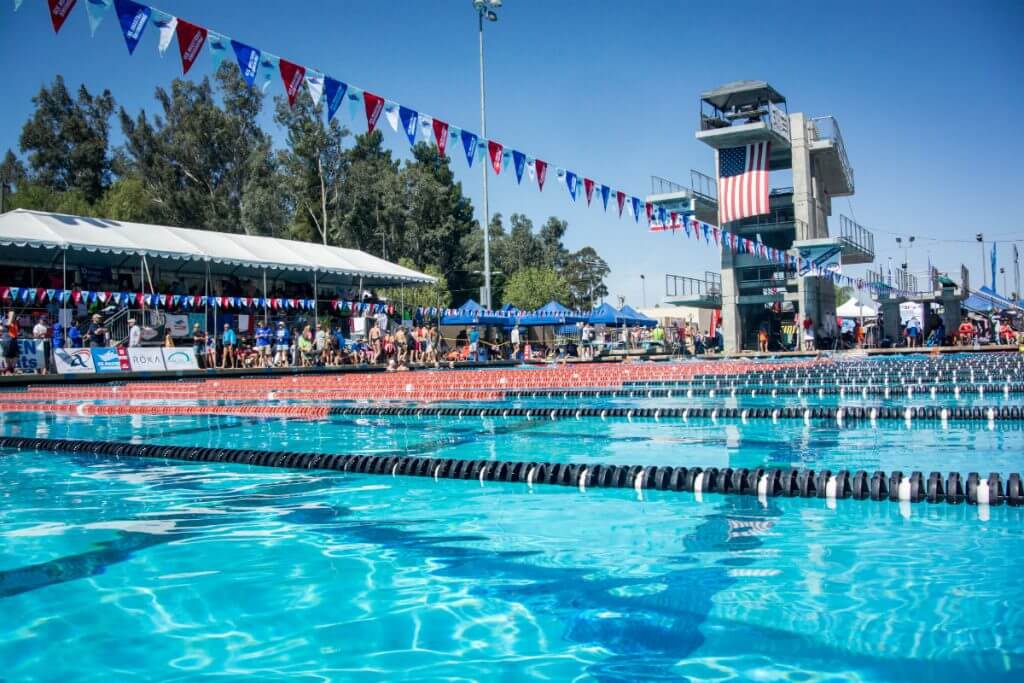US Masters Nationals Day 4 Recap: National Champions Share Advice for 50 Freestyle

US Masters Nationals Day 4 Recap: National Champions Share Advice for the 50 Freestyle
By Daniel Paulling
The 50 freestyle is the fastest race in swimming and often decided by hundredths of a second. This makes it exciting to watch but perhaps stressful to swim. Because of the small margin for error, one mistake can be the difference between first and second or hitting your personal best.
If you want to swim a faster 50 freestyle, here are tips from three swimmers who won national championships in the event on Saturday, the fourth day of the U.S. Masters Swimming Short Course National Championship in Greensboro, North Carolina.
Take Advantage of Equipment
Equipment has been the key to Carly Tanner’s training for the 50 freestyle.
One set she does often is four times through 2 x 25s drill and 2 x 25s swim on 20 seconds rest. The drills are what she calls power-based drills, such as taking powerful strokes with just one arm, and the swims are 10 to 12½ yards sprint.
Tanner mixes up the equipment she uses within each round. She’ll use a large parachute for a round of 25s drill and then a smaller parachute for the 25s swim that follow and then use the smaller parachute for the next set of drills and no equipment for the 25s swim.
Variety is important, the North Carolina Masters Swimming member believes.
“Mixing in different progressions, it kind of keeps your muscles reacting,” says Tanner, who went a 23.74 on Saturday. “I feel like doing the same thing over and over again, your body just kind of gets used to it. You’re not hitting that next level, so mixing it in and doing different lengths and intensities has been good.
“Doing those shorter blasts kind of allows you to do 110%, and then the next time you do it, you can use that intensity and then on the 10-yard blast hit that next level. It’s building up that top speed, which I think is really hard to do if you’re doing a lot of yardage.”
Tanner, 30, also loves using short-bladed fins for underwater kick sets, saying they help her engage her hips more; paddles because they help her build strength; and a snorkel because it allows her to keep her head down and focus solely on her arm placement.
Hit the Weight Room
Bruce Kone swam distance events until deciding to become a sprinter five years ago. One of the biggest keys to his transition, he believes, has been lifting weights.
The 63-year-old does strength and conditioning workouts three times a week, breaking his routine into blocks of several weeks. One block features building strength by doing bench presses and Olympic lifts such as squats and deadlifts. He pairs those exercises with a plyometric exercise during another block, and then he’ll do a block of solely speed-based exercises such as 10-yard dashes, broad jumps, plyometric jumps, and clap push-ups.
It’s hard to argue with the results. Kone, who went a 23.66 on Saturday, has routinely recorded Top 10 times in the 50s of all four strokes since he began his new routine and holds five USMS records, all of which are in 50s.
To create what he describes as his “very debilitating” weightlifting routine, Kone, an unattached member within the Gulf LMSC, reached out to several strength and conditioning specialists for help.
Although he only does between 600 and 1,000 yards three or four times a week, he focuses on building power through his work with power cords and parachutes and swimming at top speed. He describes himself as much stronger than he’s been in a long time.
“I do feel it in the water,” Kone says. “I feel it off the blocks, feel it off the walls and breakouts and underwaters.”
Build Your Lung Strength
Swim Kentucky Masters member Penny Noyes used to take two or three breaths during her 50 freestyle. Now, she takes none, following the example set by the fastest swimmers in the world.
“If I take a breath, it’s like taking one bite of ice cream,” Noyes says. “I can’t take one bit of ice cream. I have to have a whole bowl. As soon as I breathe, I feel like I have to breathe more.”
To build her lung strength, she usually does 3 x 100s kick on 1:30 with fins or 2:00 without and then 4 x 25s on 30 seconds. She focuses on doing good underwater kicks during the 25s, sometimes going all the way underwater and sometimes doing a few underwater kicks and then working on her breakout. (She recommends intervals that only allow you about 10 seconds rest on the 100s and 25s.)
When she’s swimming the 50 freestyle now, she doesn’t think about needing to take a breath, says Noyes, who holds 15 USMS records and seven FINA Masters world records. Instead, she’s focused on getting to the finish as quickly as possible.
“You’re not going into oxygen debt in that amount of time,” says Noyes, 66, who went a 26.83 on Saturday. “I was just talking to my friend about it, and she’s in her 70s. She said, ‘You might have to rethink that in about 10 years.’ It’s true. I might have to.”
USMS Records Broken
David Guthrie, Rice Aquatic Masters: men’s 60-64 50 breaststroke (28.20)
Richard McClow, Libertyville Masters: men’s 90-94 50 breaststroke (52.10)
Steve Hiltabiddle, Colonials 1776: men’s 55-59 100 butterfly (53.32)
Note: All records are subject to change pending verification.
— The above press release was posted by Swimming World in conjunction with US Masters Swimming. For press releases and advertising inquiries please contact Advertising@SwimmingWorld.com.



